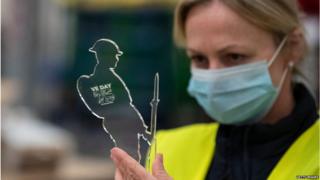Coronavirus UK map: How many confirmed cases are there in your area?
 Image copyright
Getty Images
Image copyright
Getty Images
There are now more than 200,000 confirmed coronavirus cases in the UK and more than 30,000 people with the virus have died.
The actual number of cases is estimated to be higher. Until recently it was mostly those in hospital and some NHS and care staff who were being tested - but the testing programme has now been extended.
The following charts and graphics will help you understand the situation in the UK and how the authorities are responding.
Find out how many people have confirmed cases in your area:
If you can't see the look-up click here.
The death toll of the virus
Another 649 daily deaths were announced on Wednesday, bringing the total death toll to 30,076
The UK now has the highest official death toll in Europe and the second highest in the world.
Italy's death toll, at 29,684, is the second highest in Europe. The US, with more than 71,000 deaths, has the highest toll in the world.
The government has said it is too soon to make international comparisons.
Data from the National Records of Scotland (NRS) suggest the death toll there may be 2,795 people. The NRS total includes all deaths where coronavirus was mentioned on the death certificate - which is a broader definition than those figures reported each day by the Scottish government. Currently this data, which includes only people who tested positive for the virus, has a total of 1,703 deaths.
The death total in Wales has risen to 1,044. Northern Ireland has seen 418 deaths and in England the figure is 27,008.
Recent data from the Office for National Statistics, which has provided the best picture so far of the impact on care homes, suggests that more than a fifth of all coronavirus-related deaths are happening there.
Figures published on Tuesday show that deaths in care homes are continuing to rise. In Scotland and Northern Ireland, care homes have overtaken hospitals as the place where most coronavirus deaths happen.
There is a slight time lag in the figures, which date back to 24 April, because the ONS relies on information from death certificates, rather than positive tests.
Testing below government target
More than 69,000 tests were provided on Tuesday, according to figures released on Wednesday, missing the government's 100,000-a-day target for a fourth day running.
The figure includes test kits sent to individuals or to testing locations but not yet analysed or returned, as well as tests fully processed through the relevant UK labs.
Prime Minister Boris Johnson announced on Wednesday that the government hoped to reach 200,000 tests per day by the end of May.
Ministers have said that reaching the 100,000-a-day testing target would allow the implementation of the next phase of the government's strategy to "test, track and trace" potential coronavirus cases.
As part of the strategy, the government is piloting an app on the Isle of Wight. It allows people to log coronavirus symptoms and inform those who may have been exposed to the virus that they need to isolate.
People over 65 and their households with symptoms, and anyone with symptoms who has to leave their home to work, can now book coronavirus tests.
All residents and staff in care homes in England, and patients and staff in the NHS, are eligible for tests, regardless of whether they have symptoms.
Daily cases holding steady
The numbers of confirmed daily cases had been on a downward trend, but Wednesday saw 6,111 new cases, the highest total for five days.
A spike in confirmed cases last week coincided with a significant increase in testing capacity.
Cases were originally concentrated in London, the Midlands and the North West, according to official data.
But South Wales and parts of the North West and North East also have a high proportions of cases.
The number of hospital patients has fallen
On Wednesday the government said that the number of people with coronavirus in hospitals had fallen from 15,415 to 13,168, over the past week - a decrease of almost 15%.
Figures have been gradually declining since a peak over Easter.
The Nightingale Hospital in London is being mothballed in the coming days, and will no longer be admitting patients.
The government has said making sure the NHS can cope with a second peak of the virus is one of the five conditions that must be met before lockdown is eased.
Another of the conditions is ensuring that the supply of tests and personal protective equipment (PPE) can meet future demand.
The prime minister has said he will reveal plans to begin easing the lockdown on Sunday.
Who is being most affected and where?
People living in more deprived areas of England and Wales are more likely to die with coronavirus than those in more affluent places, figures from the Office for National Statistics suggest.
ONS analysis shows there were 55 deaths for every 100,000 people in the poorest parts of England, compared with 25 in the wealthiest areas.
Most recorded coronavirus deaths have been among the elderly. Figures released by NHS England show more than half of deaths have been among people aged over 80.
There also appears to be a disproportionate impact on those from black, Asian and minority ethnic (BAME) communities.
Black people account for 6% of coronavirus deaths in hospitals in England, but only around 3.5% of the population, according to BBC analysis.
Regional data suggests the daily numbers of deaths is declining fastest in London, but other parts of England and Wales are also now seeing a decline.
London and the Midlands have seen the highest death tolls. Northern Ireland and the south west of England have seen the smallest.